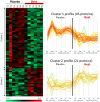Beet supplementation mitigates post-exercise inflammation
- PMID: 38873567
- PMCID: PMC11169660
- DOI: 10.3389/fnut.2024.1408804
Beet supplementation mitigates post-exercise inflammation
Abstract
Objectives: This study investigated the efficacy of a mixed beet-based supplement (BEET) versus placebo (PL) in countering inflammation during recovery from 2.25 h of intensive cycling in 20 male and female cyclists. A multi-omics approach was used that included untargeted proteomics and a targeted oxylipin panel.
Methods: A randomized, placebo-controlled, double-blind, crossover design was used with two 2-week supplementation periods and a 2-week washout period. Supplementation periods were followed by a 2.25 h cycling bout at close to 70%VO2max. The BEET supplement provided 212 mg of nitrates per day, 200 mg caffeine from green tea extract, 44 mg vitamin C from Camu Camu berry, B-vitamins from quinoa sprouts (40% Daily Value for thiamin, riboflavin, niacin, and vitamin B6), and 2.5 g of a mushroom blend containing Cordyceps sinensis and Inonotus obliquus. Six blood samples were collected before and after supplementation (overnight fasted state), immediately post-exercise, and at 1.5 h-, 3 h-, and 24 h-post-exercise.
Results: The 2.25 h cycling bout increased plasma levels of 41 of 67 oxylipins detected. BEET supplementation significantly increased plasma nitrate (NO3 -) and nitrite (NO2 -) (sum, NO3 - + NO2 -) concentrations (interaction effect, p < 0.001) and two anti-inflammatory oxylipins [18-hydroxyeicosapentaenoic acid (18-HEPE) and 4-hydroxy-docosahexanoic acid (4-HDoHE)]. The untargeted proteomics analysis identified 616 proteins (458 across all times points), and 2-way ANOVA revealed a cluster of 45 proteins that were decreased and a cluster of 21 that were increased in the BEET versus PL trials. Functional enrichment supported significant BEET-related reductions in inflammation-related proteins including several proteins related to complement activation, the acute phase response, and immune cell adhesion, migration, and differentiation.
Discussion: Intake of a BEET-based supplement during a 2-week period was linked to higher plasma levels of NO3 - + NO2 -, elevated post-exercise levels of two anti-inflammatory oxylipins, and a significant decrease in a cluster of proteins involved in complement activation and inflammation. These data support that 2-weeks intake of nitrate from a mixed beet-based supplement moderated protein biomarkers of exercise-induced inflammation in athletes.
Keywords: beets; exercise; inflammation; oxylipins; proteomics.
Copyright © 2024 Nieman, Sakaguchi, Williams, Mulani, Shivprasad Suresh, Omar and Zhang.
Conflict of interest statement
The authors declare that the research was conducted in the absence of any commercial or financial relationships that could be construed as a potential conflict of interest. The author(s) declared that they were an editorial board member of Frontiers, at the time of submission. This had no impact on the peer review process and the final decision.
Figures





Similar articles
-
A Multiomics Evaluation of the Countermeasure Influence of 4-Week Cranberry Beverage Supplementation on Exercise-Induced Changes in Innate Immunity.Nutrients. 2024 Sep 26;16(19):3250. doi: 10.3390/nu16193250. Nutrients. 2024. PMID: 39408218 Free PMC article. Clinical Trial.
-
Selective Influence of Hemp Fiber Ingestion on Post-Exercise Gut Permeability: A Metabolomics-Based Analysis.Nutrients. 2025 Apr 19;17(8):1384. doi: 10.3390/nu17081384. Nutrients. 2025. PMID: 40284247 Free PMC article. Clinical Trial.
-
Blueberry intake elevates post-exercise anti-inflammatory oxylipins: a randomized trial.Sci Rep. 2023 Jul 24;13(1):11976. doi: 10.1038/s41598-023-39269-1. Sci Rep. 2023. PMID: 37488250 Free PMC article. Clinical Trial.
-
The effect of vitamin B6 on cognition.Cochrane Database Syst Rev. 2003;(4):CD004393. doi: 10.1002/14651858.CD004393. Cochrane Database Syst Rev. 2003. PMID: 14584010
-
The Effect of Dietary Nitrate Supplementation on Endurance Exercise Performance in Healthy Adults: A Systematic Review and Meta-Analysis.Sports Med. 2017 Apr;47(4):735-756. doi: 10.1007/s40279-016-0617-7. Sports Med. 2017. PMID: 27600147
Cited by
-
Towards Precision Sports Nutrition for Endurance Athletes: A Scoping Review of Application of Omics and Wearables Technologies.Nutrients. 2024 Nov 19;16(22):3943. doi: 10.3390/nu16223943. Nutrients. 2024. PMID: 39599728 Free PMC article.
-
Gut Prevotella copri abundance linked to elevated post-exercise inflammation.J Sport Health Sci. 2025 Apr 5;14:101039. doi: 10.1016/j.jshs.2025.101039. Online ahead of print. J Sport Health Sci. 2025. PMID: 40194740 Free PMC article.
-
A Multiomics Evaluation of the Countermeasure Influence of 4-Week Cranberry Beverage Supplementation on Exercise-Induced Changes in Innate Immunity.Nutrients. 2024 Sep 26;16(19):3250. doi: 10.3390/nu16193250. Nutrients. 2024. PMID: 39408218 Free PMC article. Clinical Trial.
References
Grants and funding
LinkOut - more resources
Full Text Sources

